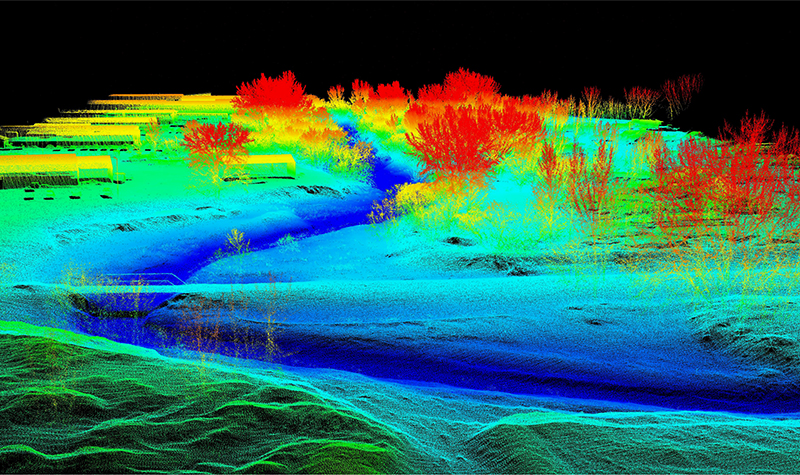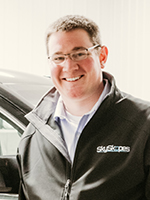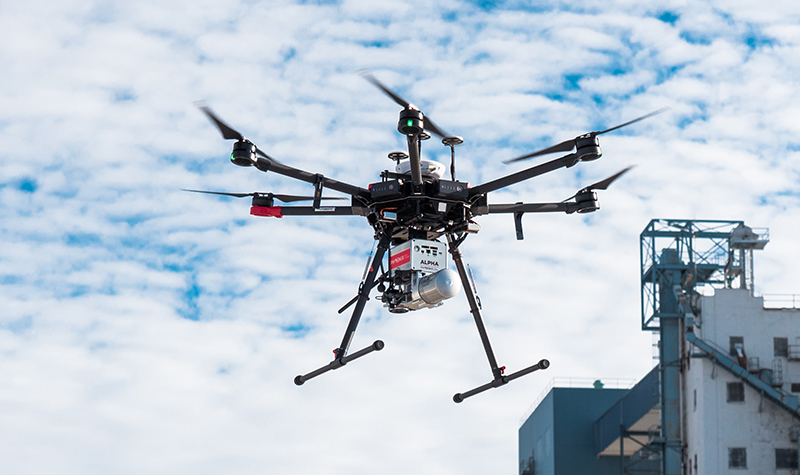Forging the future
Center for Innovation startup SkySkopes expands throughout Midwest with new vision for UAS applications

Two years is both a blink of an eye and a lifetime in the world of drones.
So says Matt Dunlevy, president and CEO of SkySkopes, Inc.
The last time UND Today wrote on the drone service provider, in 2017, they were growing their business out of the Center for Innovation at UND. SkySkopes has since expanded their foothold across the region, with offices in Grand Forks, Minot, Williston and Minneapolis, among other locations.
“Our mission is to execute unmanned aircraft systems flight operations to the highest levels of safety possible,” Dunlevy said. “That mission hasn’t changed – the vision has.”
Over the past two years, SkySkopes has redefined its service-provider focus. From its original value statement of flying drones for wedding footage, the company now situates itself as an important player in the energy industry and advancing the drone service industry overall. They were the first FAA-approved UAS service provider in North Dakota.
“When we started to realize that flying drones is more than having fun, and it’s in a fledgling state across the world, we started to move to more industrial uses such as flying more advanced sensors on more advanced airframes with pilots that wanted missions that would do their education justice,” Dunlevy said.
But, he clarifies, flying drones is still really fun.

Experts down the hall
Their westward expansion has corresponded with the oil and gas industry’s increasingly insatiable desire for light detection and ranging (LiDAR) and optical gas imaging data. Through advanced sensors, SkySkopes’ data collection can detect fugitive emissions and hydrocarbons in the Bakken oil fields.

Four or five years ago, people thought the best use for drones would be in observing above-ground infrastructure for power generation and delivery with simple cameras. The notion of attaching LiDAR or gas imaging sensors to drones wasn’t as prominent. SkySkopes’ business maneuvers, therefore, indicate an apparent industrial shift.
“Now, especially in the Bakken, it’s not 90 percent utilities and 10 percent oil and gas,” Dunlevy said of UAS applications. “It’s more neck and neck.”
The focus for SkySkopes is representative of that split. Dunlevy is proud of the fact SkySkopes drones are on the cutting edge of utilities applications, as they’ve demonstrated an ability to string power lines using their airframes. It’s a development he says wouldn’t be possible without the company’s proximity to one of the highest per capita populations of UAS subject matter experts in the country.
The CEO finds great value in that down-the-hall feeling of being around Grand Forks and the University. When it comes to staying ahead of the curve, there are few better places, he says.
“People here know aviation safety at the highest levels, and they can conceptualize components of aviation intellectually often better than anyone else,” Dunlevy said. Whether it’s talking waivers for altitude and weight restrictions at the Northern Plains UAS Test Site, or visiting the UAS engineering lab on campus to discuss methodologies for drones used in utility construction, it all seems next door and accessible.

Staying ahead
In addition to breaking barriers on the utility side, SkySkopes also leads the world’s drone service provider companies in beyond visual line of sight (BVLOS) flight. Just in mid-April, Norwegian drone manufacturer Robot Aviation partnered with SkySkopes on BVLOS flight missions in Norway.
“Robot Aviation sees the value in working with the most highly certified pilots in the United States,” Dunlevy said of the Norwegian company. “They see the value of the education our pilots receive at UND, and other top schools, as well as our experience and partnerships with other industry leaders.”
For SkySkopes, flights like this hold significance as BVLOS inevitably rolls out in the United States. As the Red River Valley rapidly develops into the first “super corridor” for domestic BVLOS flight, SkySkopes is at the tip of the spear.
“We’ve been able to show companies such as Robot Aviation that we are a preeminent window into the American market,” Dunlevy said. They hope to utilize Robot Aviation’s high-endurance aircraft in future operations, above home soil.

Perfecting the model
Dunlevy envisions a future for SkySkopes that branches both physically and entrepreneurially while perfecting the drone service provider model. They’ve already managed to expand out of North Dakota and execute missions across the United States and internationally, so it’s only a matter of time until SkySkopes can take a divisional approach to what Dunlevy calls the “drone stack.”
“You’re flying for energy, agriculture, research, BVLOS, consultation, legal advocacy, software development,” he listed. “It’s all different parts of the stack.”
In such a burgeoning industry, the aspiration is for SkySkopes to have a hand in shaping its future. For instance, line-stringing is potentially way ahead of its time, Dunlevy says.
“If we’re able to develop that in a way that’s years ahead of its supposed maturity, then we have a silver bullet product coming out of North Dakota,” he said.
As Dunlevy understands the past development of other tech industries, such as personal computing, SkySkopes’ pursuits are a leap of faith worth taking. They’ve established themselves as a trusted brand, only hiring the most qualified and certified of pilots, and remain poised to adjust their services to current regulations and available technology.

Opportunity to advance
Sitting for an interview in the Skalicky Tech Incubator, down the hall from the Center for Innovation, Dunlevy points out key spots of his old stomping grounds.
“I had that corner office back there for a couple of years – good view,” he said, pointing to spaces behind the front desk. “We would fly drones around this atrium.”
SkySkopes used to take up the space that UND Today now coincidentally occupies, as well.
The Center for Innovation was where things fell into place for the fledgling company. Its proximity to—once again—top UAS minds at the University, as well as entrepreneurial expertise within the Center, put them at a distinct advantage. Being located within the cluster, physically, helped nurture the technology they wanted to work with, and the Center’s programming helped SkySkopes secure interns and state grant funding.
“It was because of the Center that we ran into our Chief Financial Officer Dan Daffinrud, whose studies were in accounting at UND,” Dunlevy said. “He was part of Dakota Venture Group, which had their meetings down the hall from us.
“The first thing that comes to mind when I think of the Center for Innovation is the technology, and we might not have had the opportunity to advance that tech without it.”



